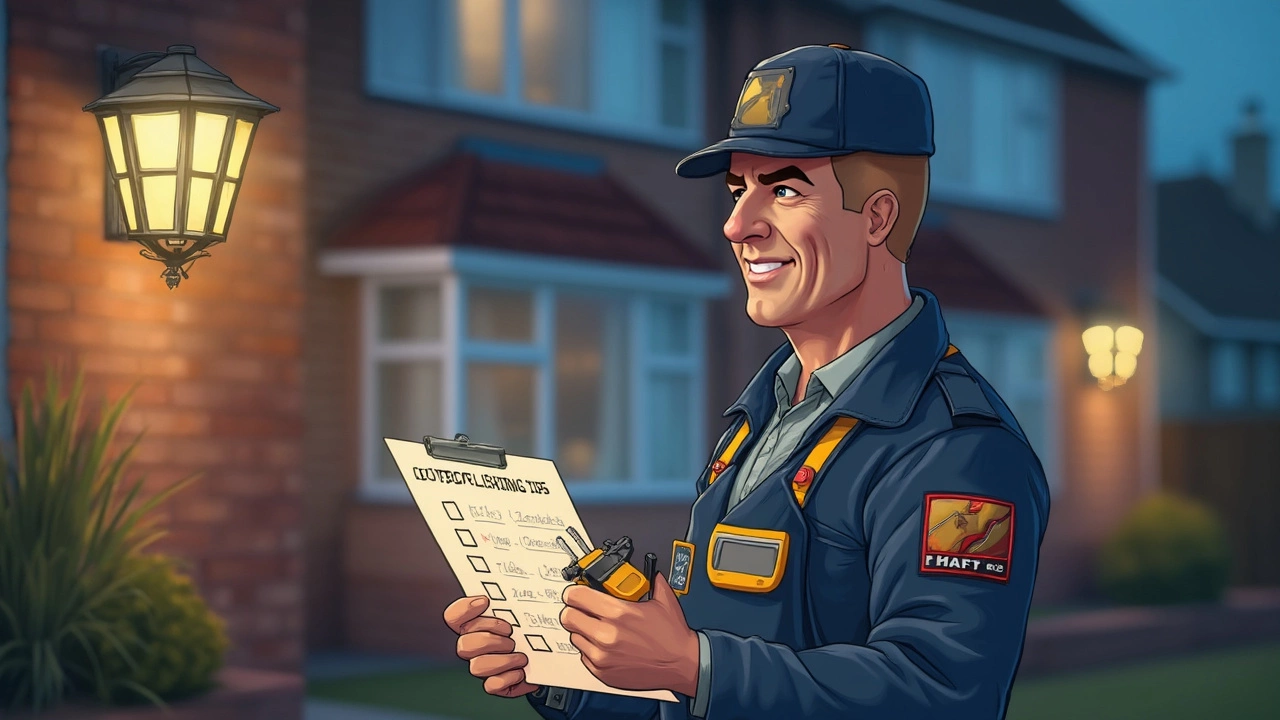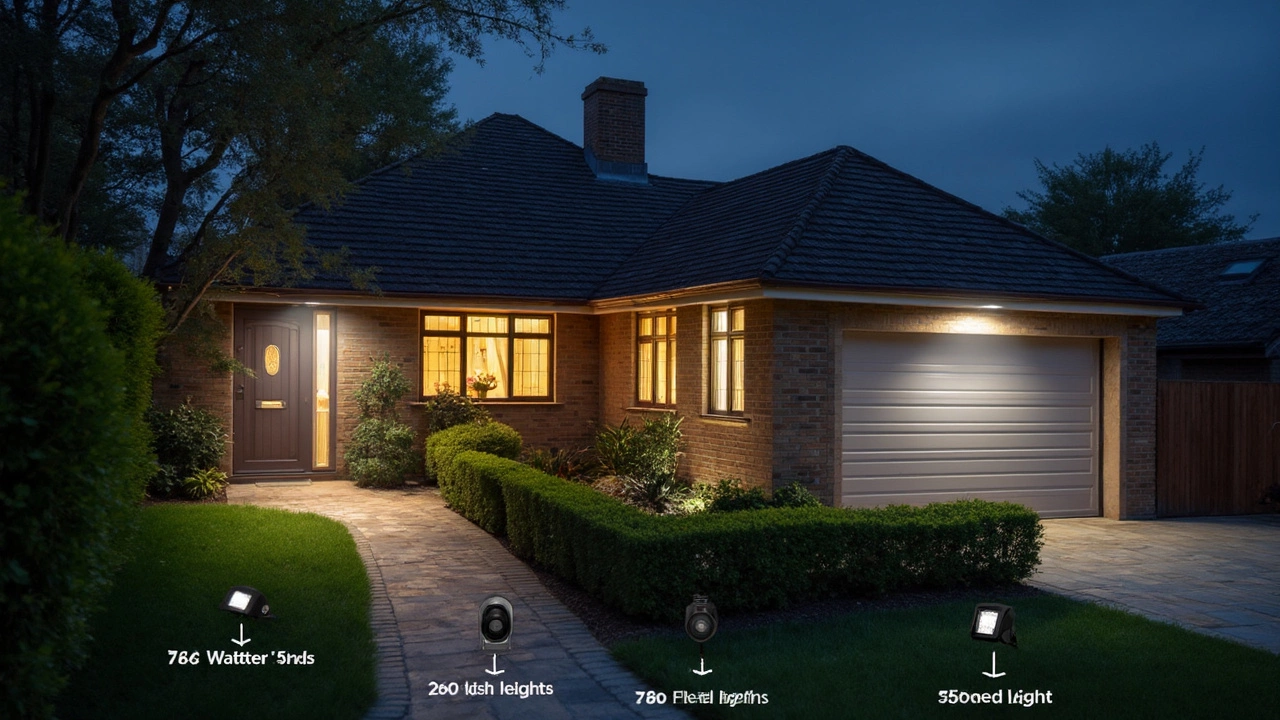Most people see a high watt number and think, "Brighter must be better!" when picking outdoor security lights. But the truth is, wattage only tells you how much energy the light uses—not how much light you actually get. Back in the day, 100-watt floodlights were common, but with LED technology, you can get the same brightness using 12 to 20 watts. Yep, that’s a huge energy (and money) saver.
So, what wattage do you actually need for outdoor security? Start by thinking about where you’ll use the light. Driveways, walkways, porches, and big backyards all need different amounts. You don’t want your neighbor’s bedroom lighting up every time a raccoon strolls by your trash cans. As a rule of thumb, smaller spaces like porches or side doors do well with 10-20 watt LED lights (about 700-1600 lumens). For wide-open areas, go up to 30-50 watts (2600+ lumens), but anything more turns your yard into a stadium—and annoys everyone nearby.
- What Does Wattage Really Mean?
- Finding the Sweet Spot: Recommended Wattage by Area
- LED vs. Halogen: Why Watts Aren’t the Whole Story
- Pro Tips for Getting the Best Coverage
What Does Wattage Really Mean?
If you’ve ever shopped for outdoor security lights, you’ve probably noticed all the talk about wattage. But here’s the deal: wattage tells you how much power the fixture pulls from your home’s electricity, not how much light it spits out. The real measure of brightness is lumens, not watts.
Back when incandescent and halogen bulbs ruled, folks used watts to guess brightness. For example, a 60-watt bulb usually meant a dimmer light than a 100-watt bulb. But LEDs flipped that script. Now, a 10-watt LED can shine as brightly as a 60-watt old-school bulb but eat up way less electricity.
Let’s compare wattage and brightness for different bulbs. Check this table for a quick reference:
| Bulb Type | Wattage | Lumens (Brightness) |
|---|---|---|
| Incandescent | 60W | 800 |
| Halogen | 42W | 800 |
| LED | 9-10W | 800 |
See those numbers? An LED uses way less wattage to crank out the same brightness as a bulky old incandescent. That means lower power bills and less heat pouring out of your fixtures.
Here’s something handy: for security lighting, try to focus on lumens. Use wattage to estimate your power use, but check the box or product description for the lumen count if you care about how bright things will be.
Just remember, watts alone don’t tell you if a light is "safe" or "enough." Always check the lumens, especially if you’re switching to LEDs or have a mix of bulb types in your yard.
Finding the Sweet Spot: Recommended Wattage by Area
Picking the right wattage isn’t about showing off or blinding your neighbors—it’s about matching brightness to the area you want covered. Different spots around your home have different needs. Let’s break it down with real numbers (and skip the guessing games).
Here’s a no-nonsense table to help you out:
| Outdoor Area | Recommended LED Wattage | Lumens Output |
|---|---|---|
| Porch / Entryway | 6 – 12 watts | 450 – 900 lumens |
| Walkways / Side Doors | 10 – 20 watts | 700 – 1600 lumens |
| Driveway | 20 – 30 watts | 1600 – 2400 lumens |
| Garage Front / Backyards | 30 – 50 watts | 2400 – 4000 lumens |
The main takeaway? You don’t need the same wattage everywhere. Lighting up your front porch with a 40-watt light is probably overkill—unless you want your Amazon driver to feel like they’re in a spotlight. On the flip side, skimping on wattage outside a garage or backyard could leave you with more shadows than light, which isn’t great for security or peace of mind.
When you see bulb packages at the store, you’ll notice some put lumens up front instead of watts. That’s because outdoor security lights are about how much light they give off (lumens), not how much energy they chew through (watts). Go for LEDs—they use way less power to pump out serious brightness compared to old-school halogen or incandescent bulbs.
Just remember: more isn’t always better. Pick wattages to fit the size and security needs of each area, and you’ll save energy, money, and neighborly goodwill.

LED vs. Halogen: Why Watts Aren’t the Whole Story
If you've ever swapped out old bulbs at home, you've probably noticed something weird: a 10-watt LED is way brighter than a 10-watt halogen. That's because LEDs are way more efficient at turning electricity into light. With halogen, a huge chunk of the energy just escapes as heat. LEDs skip the heat and give you way more light for less power.
For outdoor security lights, this matters a lot. You might see older homes with those beefy 100-watt halogen floodlights. Today, you can get that same brightness (about 1600 lumens) with a 15-20 watt LED. Here’s a head-to-head comparison to show just how wild the difference is:
| Type | Watts Used | Approx. Lumens | Lifespan (Hours) |
|---|---|---|---|
| Halogen | 100W | 1600 | 2,000 |
| LED | 15W | 1600 | 25,000+ |
See that? Less power, same brightness, and the LED outlasts the halogen by more than ten times. That’s why choosing outdoor security lights today is less about wattage and more about actual brightness, which is measured in lumens. Ignore the watt number — focus on how many lumens you’re getting for your buck.
Here’s a tip: when you’re shopping for security lighting, look for LEDs with at least 700 lumens for entrances or small spaces, and 1600+ lumens for open yards. You’ll save cash on your electric bill and won’t have to climb a ladder every year to swap burnt-out bulbs.
Another benefit? LEDs don't put out much heat, which makes them safer if you’re installing lights under eaves or next to wood siding. And if you’re worried about the cold, LEDs actually work better in freezing weather, while halogens sometimes flicker or fail when temps drop.
Pro Tips for Getting the Best Coverage
Getting the most out of your outdoor security lights isn’t just about picking a watt number and calling it a day. Where you install each light, how wide the beam spreads, and even the color temperature matter way more than you’d think. Here are some no-nonsense tips that actually work, whether you’re lighting up a small porch or a full backyard.
- outdoor security lights work best when positioned high—around 8-10 feet above the ground. This helps spread the light further and cuts down on harsh shadows that hide intruders.
- Aim the light so it points away from your house and not straight into your windows (or your eyes). You want to cover entry points, not blind yourself every time you walk outside.
- Choose fixtures with adjustable heads. They let you fine-tune your coverage as your needs change—maybe you get a new shed or fence, for example.
- If you’re running several lights, overlap the edges of the beams so there aren’t any dark patches for someone to duck into.
- Go for LEDs with color temperatures in the 4000K-5000K range. This gives you a crisp white light that helps cameras pick up faces and details. Anything lower than 3000K ("warm" white) looks nice for mood, but not for catching action on a security feed.
Surprisingly, motion sensors often get ignored or set up badly. Mount sensors slightly downward, and avoid pointing them at busy streets or trees, or you’ll just burn through bulb life with false alarms.
For reference, here’s a quick breakdown showing common wattages for different outdoor spots, and how much area you can usually cover with each:
| Area | Recommended LED Wattage | Typical Coverage (ft2) |
|---|---|---|
| Small Porch | 10-15W | 50-100 |
| Driveway | 20-30W | 150-300 |
| Backyard/Open Yard | 30-50W | 300-500+ |
Last tip—don’t skimp on quality. Cheaper fixtures love to leak, rust, or die fast. A good light means less hassle and fewer replacements.

